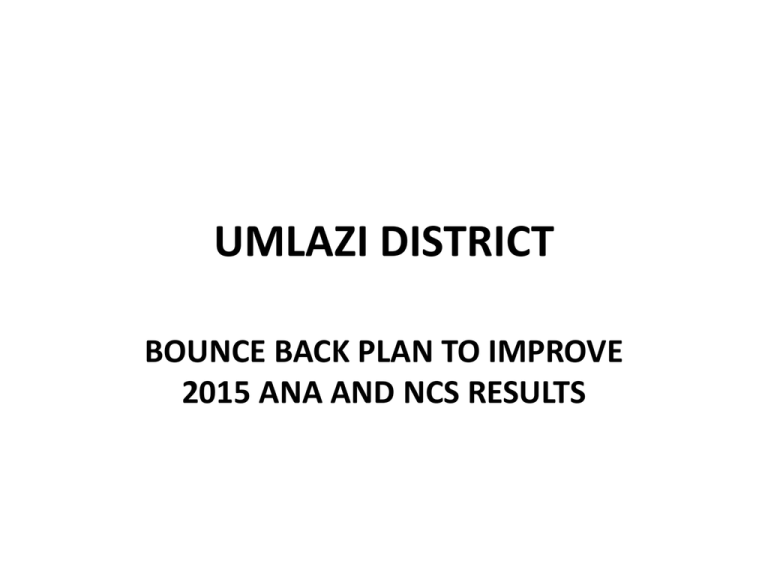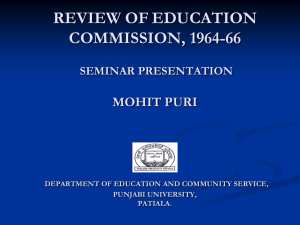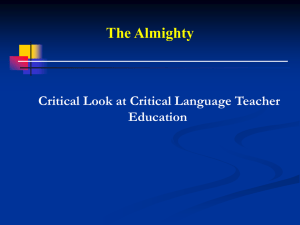- Smart Schools Network
advertisement

UMLAZI DISTRICT BOUNCE BACK PLAN TO IMPROVE 2015 ANA AND NCS RESULTS UMLAZI DISTRICT THREE LEGGED STRATEGY BASED ON 60:30:10 RATIO FOR THE DISTRIBUTION OF OUR RESOURCES IN UMBUMBULU, TOWNSHIPS AND CITY SCHOOLS RESPECTIVELY. First Leg 1. Functionality, Effective Management and Governance of schools A. Dysfunctional Schools identified by Subject Advisors in terms of the set criteria. B. Under performing schools identified in terms of the DBE circular number D1 of 2014. C. Challenges of dysfunctional and underperforming schools addressed by the Circuit Management. • Reporting on attendance of educators. Keeping the time book and leave register updated. Submission of leave forms to the circuit manager every Friday. Schools reporting directly to the Directors office every month on educators on the prolonged leave of absence. • Reporting on attendance of learners. Keeping the attendance registers of learners updated. Reporting on monthly basis to the circuit managers on dropout learners. • Reporting on control of late coming. Implementation of the circular for late coming in relation to the code of conduct for learners Officials to report to circuit managers on learners spotted loitering in uniform on the streets and malls during school time. G&M advocates the same message to the parents and communities. • Attendance of class lessons to safeguard notional time. Keeping the period register updated. Compliance with district circular number 1 of 2014 on prevention of disruption of teaching and learning. Ensuring that internal and external meetings are not conducted during the notional time. Quarterly meetings with social partners, SGB chairpersons, SGB associations, Business sector and community leaders to ensure stability and focus on classroom teaching and learning. • Other Critical Factors to Improve Attendance of Learners and Educators Regular provision of water and sanitation. Regular provision of nutritious meals in qualifying schools. Second Leg 2. Supply of Critical resources A. Dysfunctional schools identified by Subject Advisors B. Underperforming schools identified in terms of DBE circular number D1 of 2014. C. Challenges addressed by curriculum support services, curriculum GET and FET, circuit management, Governance ad management and Directors office. • Human resources. Timeous movement of surplus educators and completion of assumption of duty forms. Timeous identification and filling in of vacant posts. Capacity building of newly appointed PL1 educators and SMTs by mid February of each year. • Curriculum material resources District Teams visit schools and monitor the delivery, distribution and utilisation of the following: CAPS documents Grade R to 12. Annual Teaching Plan and Annual Programme Of Assessment per Subject per grade. National Protocol On Assessment Grade R to 12 National Policy Pertaining to The Programme and Promotion Requirements for Grade R to 12. LTSM ordered and delivered on time. LTSM distributed to learners and educators on time. Supply of exam guidelines on time. Supply of workbooks (ANA) on time. Supply of exemplars and previous papers on time. Supply of mind the gap and Siyavula study guides (NSC) on time. • Maths, Science and Technological resources. Supply of Mobile Science kits where there are NO laboratories. Conversion of Durban environmental centre to a centre focusing on Maths, Science and Technology. Supply of Maths, Science and Technological resources for the centre. Identification of Lead Educators to assist on Maths, Science and Technology at the centre. Development of lesson plans by subject advisors working with lead educators for gateway subjects. • District ICT Structure Establishment of District ICT Structure Appointment and Capacitation of ICT Co-ordinators Co-ordination and integration of ICT programmes with curriculum Capacitation of educators in each school on utilisation of ICT to advance curriculum Co-ordinate the establishment of the school e-learning system ie e-learning platform, LMS, curriculum related social network and e-assessment approach. • Other programmes and projects as resources. Partnerships with NGO’s, Companies, local businesses, SGB associations and religious leaders to access various resources and community mobilisation. The use of good former principals of schools to advise and motivate underperfoming school’s principals. Partnership with local public libraries to promote reading. Determination of routes for a mobile library bus to assist disadvantaged schools and monitoring of compliance with reading policy. Establishment of corner libraries where there are no libraries to promote reading. Readathon, spelling bee and promulgation of setting aside reading time to promote literacy. Introduction of mental maths and mathematical tables in the morning in schools to promote numeracy. Twining underperforming schools with best Schools to share good practices. Mentorship programme for all dysfunctional, underperforming and big schools and appointment of mentors. Mentors to assist the school with a swot analysis and the development of a turnaround strategy and monitor its implementation. Quarterly Parental involvement on learner’s academic performance and advocacy on concessions and Subject choices especially in grade 9. Ex-student society ( alumni ), motivational sessions in February and August of each year and other support programmes to mobilise participation of community members and other stakeholders in advancing QLTP. Third Leg 3. Subject Advisory Services A. Dysfunctional schools identified by Circuit Managers. B. Underperforming schools identified in terms of DBE circular number D1 of 2014. C. Challenges addressed by subject advisors and circuit managers. • Curriculum analysis and support. Conduction of NSC and ANA diagnostic and items analysis and conduct orientation workshops plus quarterly content workshops for gateway subjects. Provision of NSC and ANA exam guidelines and exemplars and their utilization. Skills audit be done for scarce subjects educators for subject advisors to provide relevant and informed on site school visits support. SMTs trained on instructional leadership, assessment strategies, SBA monitoring and curriculum management. Development and implementation of subject improvement plans by subject advisors to support educators. Evidence of schools visited by subject advisors/circuit managers and specific items addressed per subject. Educators assisted with content knowledge gaps and assessment strategies. Educators assisted with methodological issues on problematic areas. Subject Advisors to prepare methodological tips on problematic areas so that a methodological document is made available for consumptions by Educators). Eg Document will have methodological approach and Revision strategies. Educators assisted with the utilisation of LTSM, Textbooks, Workbooks ,previous exam question papers. Strengthen SBA monitoring and control quarterly through online form by Subject Advisors to detect under Performance early so that strategic curriculum intervention is implemented urgently to avoid surprises of poor performance during summative assessment. • Curriculum coverage Build and strengthen subject committees. Mop up trainings on CAPS. Capacitation of SMT on curriculum coverage monitoring Capacitation of educators on subject specific gaps in terms of items analysis. Timeous completion of syllabi and beginning of revision processes ( end of August for grade 12). • Critical Intervention to Improve ANA Results in Grade 9 Meetings for all Grade 9 lead educators. Special meeting of all Grade 9 Maths and Languages educators. ANA presentation of results. Grade 9 ANA discussions of critical areas of Mathematics and Languages. Quarterly content workshops for educators to address critical areas. Monthly subject committee meetings for Maths and Languages are held and monitored. Winter training programme for Grade 9 Maths and Language educators on content knowledge. Quarterly common tests administered by all Grade 9 schools regardless of their performance in Maths and Language, quarterly release of results, items analysis and relevant intervention conducted. Conduct Mathematics Olympiads, Language contests, EMS Quiz and NST Expos. •Extra classes and holiday classes on gateway subjects Syllabi Coverage Programme: Internal Educators conducting extra classes to support/supplement ordinary class lessons in the morning and afternoon 100% Bachelors Programme: Programme for assisting 100% schools to achieve 100% Bachelors. 100 % schools programme : Programme for 80 – 99% quintile 5 and non quintile 5 schools to assist them to be 100% schools. Under 60% Schools Programme: Lead Educators appointed to teach learners in underperforming schools during Saturdays, Winter Holidays and revision during Spring Holidays. Under 20 % Schools Programme : Lead educators appointed to teach learners in underperforming schools during Saturdays, Easter holidays, winter holidays and revision during spring holidays. NSC/ANA fast track Programme: Programme for learners who progressed to the next grade on the basis of phase progression requirements to assist them on improvement of their performance. SBA intervention Programme: Quarterly identification of under performing learners on the basis of SBA to assist them on improvement of their performance. Distinctions Programme : Lead educators identified to teach high performing learners of poorly resourced schools on Saturdays. High Risk Schools Programme : Lead educators identified to teach schools which are regularly in and out of the underperformance bracket. Learners taught on Saturdays, Winter holidays and revision during spring holidays. Perpetual Under Performing Schools Programme: Lead Educators identified to assist schools which have stayed in under performance bracket for the past three years and more without moving out. Learners taught on Saturdays, Easter Holidays, Winter Holidays and revision during Spring Holidays. Big Schools Programme: Lead Educators identified to teach schools with 300 or more learners in matric on Saturday, Winter Holidays and revision during Spring Holidays. THANK YOU !!!






